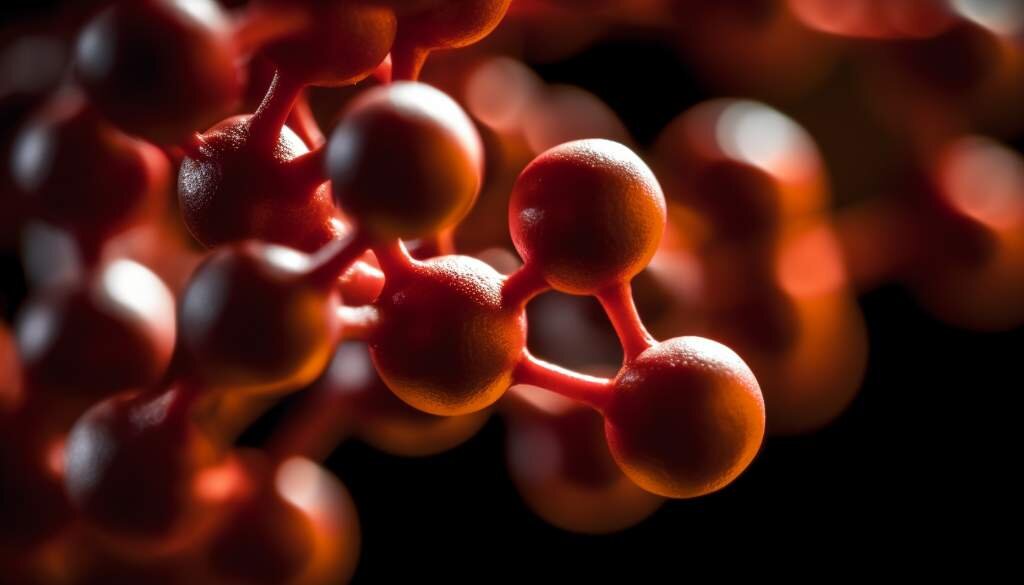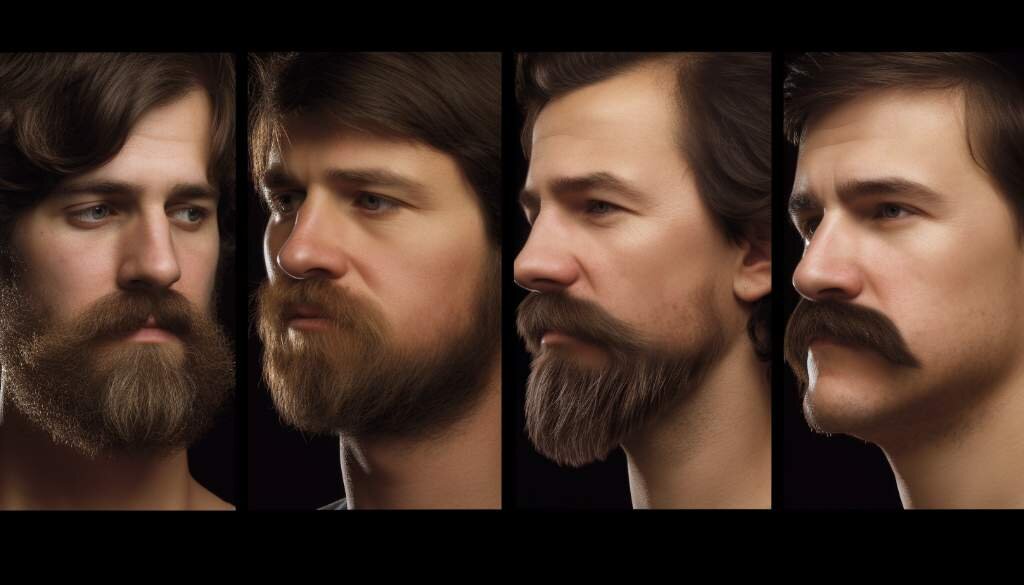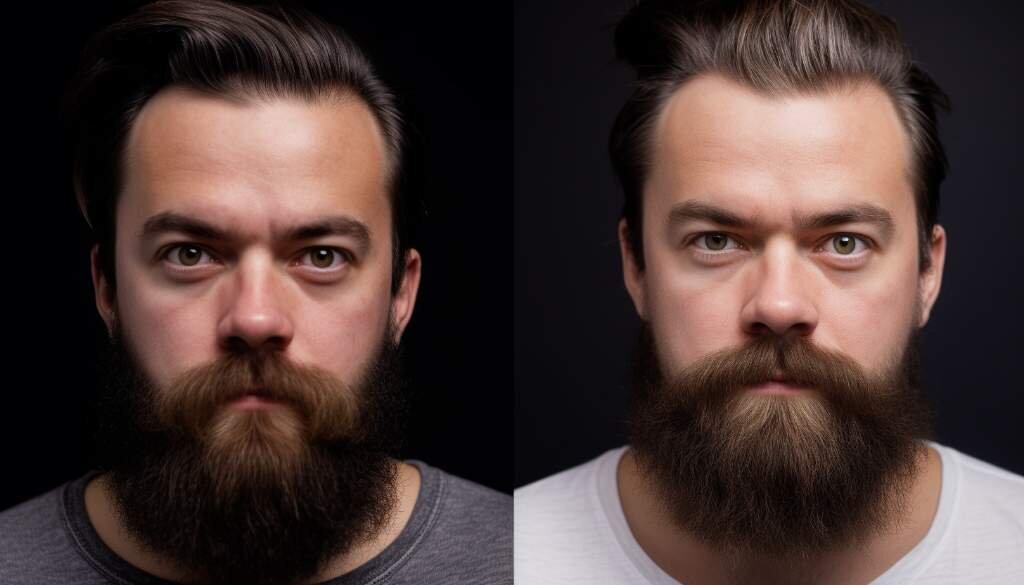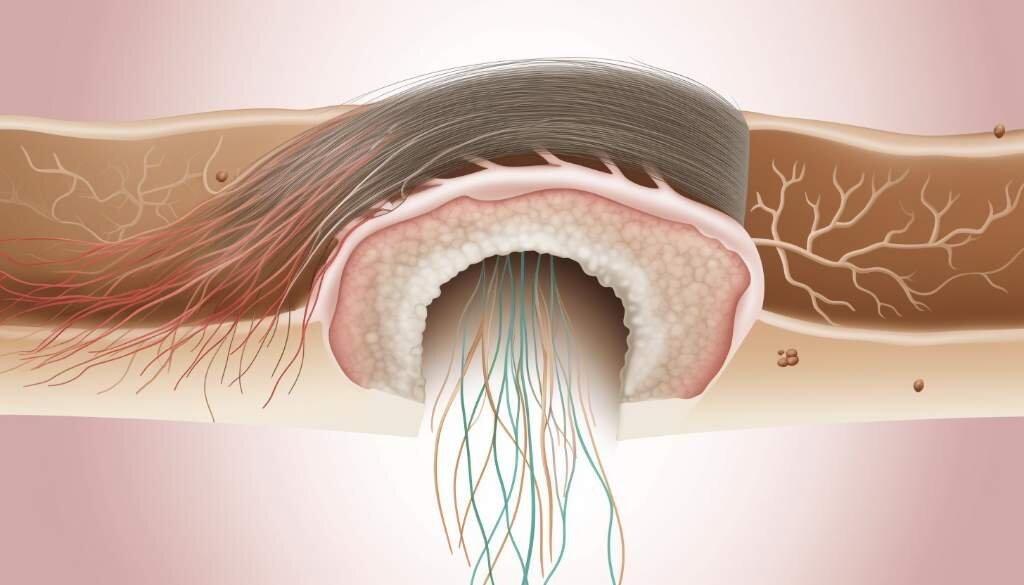
Understanding Testosterone and its Role in Facial Hair Growth
Understanding testosterone and its role in facial hair growth is crucial for anyone looking to enhance their beard growth. Testosterone plays a significant role in the development of male characteristics, including facial hair. In this section, we will explore the relationship between testosterone and facial hair growth, the influence of genetics on beard growth, natural ways to boost testosterone levels, and effective beard care and grooming routines. Let's dive into the details!
How does testosterone affect facial hair growth?
Testosterone, a crucial hormone in the male body, plays a significant role in facial hair growth. When testosterone levels rise during puberty, it triggers the development of masculine characteristics, including the growth of facial hair.
Testosterone affects facial hair growth in several ways. Firstly, it stimulates the growth of hair follicles on the face. These follicles are located in the dermis, the inner layer of the skin, and produce hair strands. When testosterone binds to androgen receptors present in these follicles, it activates the production of proteins necessary for hair growth.
Furthermore, testosterone promotes the growth of terminal hair, which is thicker and darker compared to vellus hair (peach fuzz). As testosterone levels increase, vellus hair on the face begins to transform into terminal hair, resulting in the growth of a beard, mustache, and sideburns.
The effects of testosterone on facial hair growth are further influenced by the conversion of testosterone into dihydrotestosterone (DHT), a more potent androgen hormone. DHT binds to androgen receptors in the hair follicles with greater affinity, stimulating the growth of terminal hair even more effectively than testosterone alone.
However, it is important to note that testosterone is not the sole determinant of facial hair growth. Genetics also play a significant role in determining the ability to grow facial hair. Some individuals may have a genetic predisposition for thicker and fuller facial hair, while others may have less pronounced or patchy facial hair growth.
In conclusion, testosterone influences facial hair growth by stimulating the growth of hair follicles and promoting the transformation of vellus hair into terminal hair. This hormone, along with the conversion to DHT, triggers the development of a beard, mustache, and other facial hair. However, the extent of facial hair growth also depends on genetic factors, which determine individual variations. Understanding the role of testosterone in facial hair growth can help individuals better comprehend the complexities of their own hair growth patterns.
The relationship between testosterone and dihydrotestosterone (DHT)
The relationship between testosterone and dihydrotestosterone (DHT) is crucial in understanding how facial hair growth is affected. Testosterone is a hormone that plays a significant role in the development of male secondary sexual characteristics, including facial hair growth. However, it is not directly responsible for the growth itself.
DHT, on the other hand, is an androgen hormone derived from testosterone. It is the more potent form of testosterone and plays a vital role in stimulating the growth of facial hair. DHT binds to androgen receptors in hair follicles, activating them and promoting the development of facial hair.
The conversion of testosterone into DHT is facilitated by the enzyme 5-alpha reductase. This enzyme acts on testosterone, converting it into DHT in certain tissues and organs, including the hair follicles. The levels of 5-alpha reductase can vary among individuals, which may contribute to differences in facial hair growth.
It is important to note that while both testosterone and DHT are necessary for facial hair growth, imbalances in their levels can have an impact. High levels of DHT, for example, may cause the hair follicles to become more sensitive, leading to hair loss or male pattern baldness. Conversely, low levels of DHT may result in insufficient stimulation for facial hair growth.
Understanding the relationship between testosterone and DHT is crucial for individuals looking to enhance their facial hair growth. While testosterone levels can be boosted through various methods, it is essential to keep DHT levels in balance to achieve optimal growth.
However, it is important to note that manipulating hormone levels should be done with caution. Hormonal imbalances can have potential side effects and should be discussed with a healthcare professional.
Factors that influence testosterone levels
Testosterone levels in the body can be influenced by various factors. Understanding these factors can help individuals make informed decisions to optimize their testosterone levels and promote facial hair growth. Here are some key factors that influence testosterone levels:
- Diet and nutrition: A healthy and balanced diet plays a significant role in testosterone production. Nutrients such as zinc, vitamin D, and omega-3 fatty acids have been shown to support healthy testosterone levels. Foods like oysters, eggs, fatty fish, and nuts can be beneficial for testosterone production.
- Exercise and physical activity: Regular exercise can help increase testosterone levels. Strength training and high-intensity interval training (HIIT) have been particularly effective in boosting testosterone. Aim for a combination of cardiovascular exercise, weightlifting, and resistance training to optimize testosterone production.
- Lifestyle factors: Certain lifestyle choices can impact testosterone levels. Chronic stress, lack of sleep, and excessive alcohol consumption can all contribute to decreased testosterone production. Managing stress, getting enough sleep, and moderating alcohol intake are important for maintaining healthy testosterone levels.
- Environmental factors: Exposure to certain environmental toxins can interfere with testosterone production. Chemicals found in plastics, pesticides, and other pollutants can disrupt the body's hormone balance. When possible, try to reduce exposure to these harmful substances.

Genetics and Facial Hair Growth
Genetics plays a significant role in determining the growth of facial hair. Facial hair growth is influenced by a combination of genetic factors that determine the presence and activity of certain hormones.
In general, genetics determines how responsive hair follicles are to hormones like testosterone, which is the main driver of facial hair growth. Testosterone is converted into dihydrotestosterone (DHT) by an enzyme called 5-alpha reductase. DHT is the more potent form of testosterone and is responsible for stimulating the growth of facial hair.
In this section, we will explore the role of genetics in determining beard growth and whether it is possible to change your genetic predisposition for facial hair growth. We will also discuss the relationship between testosterone and DHT, and the various factors that influence testosterone levels.
The role of genetics in determining beard growth
The role of genetics in determining beard growth is significant and plays a crucial role in the thickness, density, and distribution of facial hair. Genetics are primarily responsible for determining whether an individual will have a full beard, a patchy beard, or limited facial hair.
Genes are the instructions that determine the characteristics of an organism, including facial hair growth patterns. These genes are passed down from parents to their offspring, meaning that if your father or other male relatives have thick beards, you are more likely to have a similar beard growth pattern.
A key determinant in facial hair growth is the level of sensitivity of hair follicles to androgens, particularly dihydrotestosterone (DHT). Androgens, including testosterone, bind to hair follicle receptors and stimulate the growth of facial hair. However, the degree to which hair follicles respond to androgens is influenced by genetic factors.
Studies suggest that specific genes, such as the androgen receptor gene (AR) and the genes involved in the production of enzymes that convert testosterone to DHT, may play a crucial role in determining the beard growth potential of an individual. Variations in these genes can result in variations in the sensitivity of hair follicles to androgens, ultimately affecting the growth of facial hair.
It is worth noting that while genetics play a significant role in beard growth, they are not the only determining factor. Other factors, such as hormonal levels, lifestyle choices, and overall health, can also impact the growth and thickness of facial hair. For example, high levels of stress, poor diet, and lack of exercise can negatively affect testosterone levels, which in turn can affect beard growth.
Can you change your genetic predisposition for facial hair growth?
Your genetic predisposition for facial hair growth is largely determined by your genes. Beard growth is influenced by a variety of genetic factors, including the presence of specific genes that regulate the production of hormones such as testosterone and dihydrotestosterone (DHT).
Hormones like testosterone play a crucial role in facial hair growth. They stimulate the hair follicles on your face, promoting the growth of facial hair. However, the level of testosterone and DHT production is determined by your genes.
While you cannot change your genetic makeup or alter your genes to directly influence facial hair growth, there are certain lifestyle factors that can indirectly impact the expression of these genes. Although they may not change your genetic predisposition for facial hair growth, they can help you optimize and make the most of what you have. Here are a few tips:
- Eat a balanced diet rich in nutrients that support healthy hormone production. This includes foods like lean meats, fish, nuts, seeds, fruits, and vegetables.
- Exercise regularly, as physical activity has been shown to increase testosterone levels. Focus on compound exercises like squats, deadlifts, and bench presses.
- Manage stress levels, as chronic stress can lower testosterone levels. Incorporate stress-reducing activities like meditation, yoga, or hobbies you enjoy.
- Get enough quality sleep, as inadequate sleep can negatively impact hormone production. Aim for 7-9 hours of uninterrupted sleep each night.
- Avoid smoking and excessive alcohol consumption, as these habits can interfere with hormone production and overall health.
By adopting a healthy lifestyle and following these tips, you can support optimal hormone production and create an environment conducive to healthy facial hair growth. While you may not be able to change your genetic predisposition, you can maximize your potential and promote the growth of the beard you were born with.

Natural Ways to Boost Testosterone for Facial Hair Growth
Boosting testosterone naturally can help stimulate facial hair growth. Testosterone is a hormone that plays a crucial role in the development of male secondary sexual characteristics, including facial hair. Natural ways to increase testosterone levels can range from dietary changes and exercise to lifestyle adjustments.
In this section, we will explore various methods to naturally boost testosterone levels for promoting facial hair growth. We will discuss diet and nutrition tips, including foods that are beneficial for testosterone production. Additionally, we will look into the impact of exercise on testosterone levels and recommend specific exercises that can help increase testosterone production. Furthermore, we will explore lifestyle changes that can support healthy testosterone levels and contribute to facial hair growth.
By implementing these natural methods, you can optimize your testosterone levels to stimulate facial hair growth. Let's dive into the various ways to boost testosterone naturally!
Diet and nutrition tips for increasing testosterone levels
Diet and nutrition play a crucial role in increasing testosterone levels, which can have a direct impact on facial hair growth. By consuming the right foods and ensuring adequate nutrient intake, you can naturally boost your testosterone levels and promote healthier and fuller facial hair growth.
Here are some diet and nutrition tips to consider:
- Incorporate healthy fats into your diet: Healthy fats are essential for hormone production, including testosterone. Include foods such as avocados, nuts and seeds, olive oil, and fatty fish like salmon in your diet.
- Consume an adequate amount of protein: Protein is crucial for building and repairing tissues, including hair follicles. Ensure you have enough lean sources of protein, such as chicken, fish, eggs, and legumes.
- Get enough zinc: Zinc is an essential mineral for testosterone production. Include foods rich in zinc, such as oysters, beef, pumpkin seeds, and spinach, in your diet.
- Optimize your vitamin D levels: Vitamin D deficiency has been linked to low testosterone levels. Spend some time in the sun to get natural vitamin D or consider taking a vitamin D supplement.
- Include cruciferous vegetables: Cruciferous vegetables like broccoli, cauliflower, and Brussels sprouts contain a compound called indole-3-carbinol, which can help balance hormone levels and support testosterone production.
- Avoid excessive alcohol consumption: Alcohol can have a negative impact on testosterone levels. Limit your alcohol intake to support healthy testosterone production.
- Reduce or eliminate processed foods: Processed foods often contain unhealthy fats, sugar, and additives that can disrupt hormone balance and decrease testosterone levels. Opt for whole, unprocessed foods whenever possible.
By following these diet and nutrition tips, you can optimize your testosterone levels and support healthy facial hair growth. However, it's important to note that individual results may vary, and it's always best to consult with a healthcare professional before making any significant dietary changes or starting any new supplements.
Exercise and its impact on testosterone production
Exercise plays a crucial role in boosting testosterone levels, which in turn can contribute to facial hair growth. Regular physical activity has been shown to increase testosterone production and improve overall hormonal balance in the body.
There are several ways in which exercise impacts testosterone production:
- Aerobic exercise: Engaging in activities such as running, cycling, or swimming can help stimulate the production of testosterone. Aerobic exercise increases blood flow, which delivers oxygen and nutrients to the testes, where testosterone is produced. Additionally, aerobic exercise has been found to reduce levels of cortisol, a stress hormone that can inhibit testosterone production.
- Resistance training: Lifting weights and engaging in strength training exercises can have a significant impact on testosterone levels. Resistance training puts stress on the muscles and stimulates the release of testosterone. Compound exercises that target large muscle groups, such as squats and deadlifts, are particularly effective.
- High-intensity interval training (HIIT): HIIT involves short bursts of intense exercise followed by brief recovery periods. This type of workout has been shown to increase testosterone levels and improve overall hormonal balance. HIIT workouts can be performed with various exercises, including sprinting, cycling, or bodyweight exercises like burpees and mountain climbers.
It's important to note that the duration and intensity of exercise can influence testosterone production. Moderate to high-intensity workouts of approximately 30-60 minutes have been found to be effective in increasing testosterone levels. However, excessive exercise or overtraining can have the opposite effect and suppress testosterone production.
In addition to promoting testosterone production, exercise also offers other benefits that can support facial hair growth. Regular physical activity can improve blood circulation, which helps deliver important nutrients to hair follicles. It can also help reduce stress levels, as chronic stress has been linked to hormonal imbalances that can negatively affect facial hair growth.
In conclusion, incorporating regular exercise into your routine can have a positive impact on testosterone production, supporting facial hair growth. Aerobic exercise, resistance training, and high-intensity interval training are all effective methods for boosting testosterone levels. Remember to find a balance and avoid excessive exercise, as it can have the opposite effect. Alongside exercise, other natural ways to boost testosterone, such as maintaining a healthy diet and making lifestyle changes, can work synergistically to enhance facial hair growth.
Lifestyle changes to support healthy testosterone levels
Lifestyle changes can play a significant role in supporting healthy testosterone levels, which in turn can promote facial hair growth. By adopting certain habits and making adjustments to your daily routine, you can optimize your testosterone production and enhance your chances of growing a fuller beard.
One of the most crucial lifestyle changes you can make to support healthy testosterone levels is getting adequate sleep. Lack of sleep or poor sleep quality can lead to a decrease in testosterone production. Aim for 7-9 hours of uninterrupted sleep each night to ensure your body has enough time to rest and recover.
Regular exercise is another lifestyle change that can positively impact testosterone levels. Engaging in both cardiovascular exercises and strength training can help boost testosterone production. Exercises like weightlifting, HIIT workouts, and compound movements are particularly effective in increasing testosterone levels.
Managing stress is also essential for maintaining healthy testosterone levels. Chronic stress can lead to elevated cortisol levels, which can inhibit testosterone production. Incorporating stress management techniques such as meditation, yoga, deep breathing exercises, and regular relaxation activities into your routine can help reduce stress and support optimal testosterone levels.
Diet plays a crucial role in testosterone production as well. It's important to consume a balanced diet with plenty of protein, healthy fats, and micronutrients. Foods rich in zinc, vitamin D, magnesium, and omega-3 fatty acids can specifically support testosterone levels. Consider incorporating foods such as lean meats, fish, nuts, seeds, leafy greens, and dairy products into your meals.
Lastly, it's important to minimize exposure to endocrine-disrupting chemicals that can interfere with hormone production. These chemicals can be found in certain plastics, pesticides, and personal care products. Opt for glass or stainless steel containers, choose organic produce, and use natural, chemical-free grooming products to reduce your exposure to these harmful substances.

Beard Care and Grooming for Optimal Growth
Beard Care and Grooming for Optimal Growth involves the practices and techniques used to promote healthy beard growth and maintain a well-groomed appearance. Taking care of your beard is essential to ensure it grows to its full potential and looks its best. In this section, we will explore various aspects of beard care and grooming that can help you achieve optimal beard growth.
Effective beard care routine for promoting growth
Proper beard care routine plays a crucial role in promoting healthy beard growth. Here are some effective tips to incorporate into your daily routine:
- Washing and exfoliating: Regularly washing your beard helps remove dirt, oil, and dead skin cells that can clog hair follicles and hinder growth. Use a gentle beard shampoo or soap to cleanse your facial hair, and consider exfoliating once or twice a week to prevent ingrown hairs.
- Conditioning: Just like the hair on your head, your beard benefits from conditioning. Apply a beard conditioner or natural oils, such as argan oil or jojoba oil, to keep your facial hair moisturized and nourished.
- Brushing and combing: Brushing or combing your beard helps distribute natural oils, untangle hair, and stimulate blood flow to the follicles. Use a boar bristle brush or a wide-toothed comb for best results.
- Trimming and shaping: Regularly trimming your beard helps eliminate split ends and maintain a neat appearance. Invest in a good quality beard trimmer or visit a professional barber for precise shaping.
- Avoiding excessive styling products: While styling products can enhance your beard's appearance, excessive use of gels, waxes, and sprays can clog hair follicles and restrict growth. Use products sparingly and opt for natural alternatives when possible.
- Maintaining a healthy lifestyle: Your overall health can impact beard growth. Ensure you are getting enough sleep, managing stress, and following a balanced diet rich in vitamins, minerals, and protein. Adequate hydration is also essential for healthy hair growth.
By following these effective beard care practices, you can create an optimal environment for beard growth and achieve a healthy, well-groomed beard.
Tips for maintaining a healthy and well-groomed beard
Maintaining a healthy and well-groomed beard is essential for optimal growth and appearance. Here are some tips to help you keep your beard looking its best:
- Regularly trim your beard: Trimming your beard helps to remove split ends and prevent it from becoming unruly. Use a sharp pair of scissors or a beard trimmer to carefully trim your beard to your desired length.
- Wash your beard regularly: Just like the hair on your head, your beard needs to be kept clean. Use a mild beard shampoo or a gentle cleanser to wash your beard and remove any dirt, oil, or product buildup. Be sure to thoroughly rinse your beard and pat it dry with a clean towel.
- Moisturize your beard: To keep your beard soft and hydrated, apply a beard oil or balm regularly. These products help to nourish the skin underneath your beard and prevent dryness and itchiness. Massage the oil or balm into your beard and down to the skin to promote healthy hair growth.
- Comb or brush your beard: Use a wide-toothed beard comb or a brush specifically designed for beards to detangle and style your beard. This helps to distribute natural oils and keeps your beard looking neat and well-groomed.
- Avoid over-styling and heat: Excessive heat from hairdryers or styling tools can cause damage to your beard. Try to air dry your beard whenever possible and limit the use of heated styling tools. If you must use a hairdryer, use the lowest heat setting and keep it at a safe distance from your beard.
- Protect your beard from the elements: Extreme weather conditions, such as cold winds or hot sun, can dry out your beard and make it brittle. Consider wearing a scarf or using a beard balm with SPF to protect your beard from these harsh environmental factors.
- Eat a balanced diet: Good nutrition plays a vital role in maintaining a healthy beard. Make sure you are consuming enough vitamins, minerals, and proteins, which are essential for hair growth. Include foods such as lean meats, fish, fruits, vegetables, and nuts in your diet.
By following these tips, you can ensure that your beard remains healthy, well-groomed, and looking its best.








